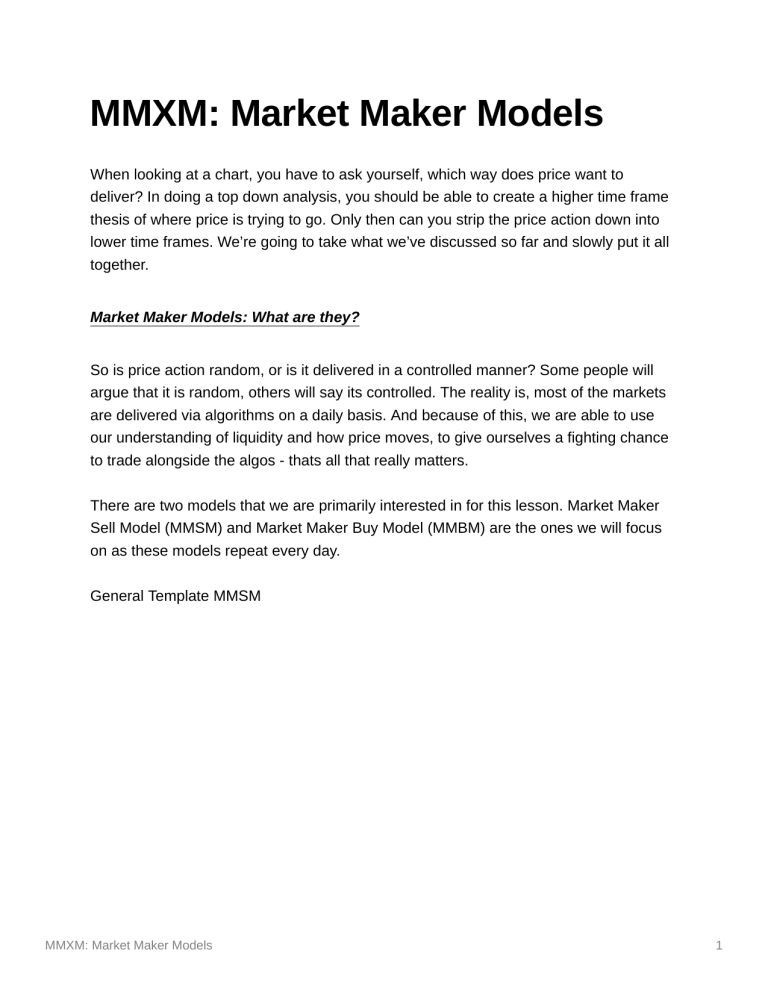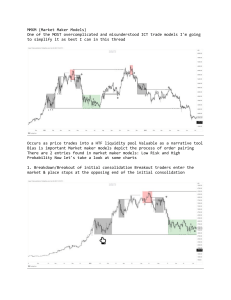
MMXM: Market Maker Models When looking at a chart, you have to ask yourself, which way does price want to deliver? In doing a top down analysis, you should be able to create a higher time frame thesis of where price is trying to go. Only then can you strip the price action down into lower time frames. We’re going to take what we’ve discussed so far and slowly put it all together. Market Maker Models: What are they? So is price action random, or is it delivered in a controlled manner? Some people will argue that it is random, others will say its controlled. The reality is, most of the markets are delivered via algorithms on a daily basis. And because of this, we are able to use our understanding of liquidity and how price moves, to give ourselves a fighting chance to trade alongside the algos - thats all that really matters. There are two models that we are primarily interested in for this lesson. Market Maker Sell Model (MMSM) and Market Maker Buy Model (MMBM) are the ones we will focus on as these models repeat every day. General Template MMSM MMXM: Market Maker Models 1 General Template MMBM MMXM: Market Maker Models 2 Market Maker Models: How do they work? These models work based on where the Draw on liquidity (DoL) is and whether it is a low resistance liquidity run. All this means, is structure should support the direction of price and not oppose it (it should not provide resistance to your narrative). The different draws on liquidity provide us with a possible narrative - the market structure is what guides us in our reading of HTF price action. A general idea of a MMSM: → Price expansion DOWNWARDS towards sellside liquidity MMXM: Market Maker Models 3 → Do you spot the Optimal Trade Entry (OTE)? → Do you spot the silver bullet (the 2nd entry)? → Retracements into FVG’s are where shorts will re-distribute A general idea of a MMBM: → Price expansion UPWARDS towards buyside liquidity MMXM: Market Maker Models 4 It should say equal highs* → Do you spot the Optimal Trade Entry (OTE)? → Do you spot the silver bullet (the 2nd entry)? → Pullbacks into FVG’s are where longs will re-accumulate For both models, price will be looking to EXPAND towards the draw on liquidity. In doing so, it will create FVG’s and order blocks, giving us a chance to add into the model trend. Our range of opportunity is from the point of start of the model to the end at the target liquidity. Let’s dive into each model with more detail and specificity. Market Maker Buy Model (MMBM) → Identify higher time frame Point of Interest (Quarterly, Monthly, Weekly, Daily) - MMXM: Market Maker Models 5 → use IPDA (interbank price delivery array - ICT lingo) look back periods of 20, 40, 60 days. [Just look at the highs and lows formed with each period mentioned] → What is the specific draw on liquidity? →OLD highs or lows, liquidity pool, equal highs or lows, OLD PD Arrays, and inefficiencies (imbalances such as SIBI or BISI, FVG’s, voids, gaps). Seeing the initial base of the MMBM comes from the impulse move lower into a HTF discount of an array, and then displaces and creates a market structure shift UP. Paired with a reason to move higher (liquidity), you should be anticipating opportunities to join the trend and capture the range presented. This is what adding into the MMBM should look like: MMXM: Market Maker Models 6 You are adding into internal liquidity FVG’s and orderblocks, and are selling for profit in external liquidity. Internal liquidity refers to the area inside of a swing high and swing low (any time frame). When price breaks the swing high or low, it has moved from inside of the range to outside of the range. Therefore, it is known to have moved from internal liquidity to external liquidity. Why does price move this way? When price drops into a discount, sellers are being absorbed by longs in liquidity. This is known as the accumulation phase of the buy-model (shown below). There is usually a quick drop followed by an energetic displacement up. This should create the initial market structure shift. MMXM: Market Maker Models 7 Once this happens, you will use market structure to add to into the trend. You will be looking for orderblocks or FVG’s to add into. In doing so, you are re-accumulating long positions with smart money to target the HTF draw on liquidity. This is where longs will look to exit, also called offset-distribution (above old highs - where shorts are positioned with their stops). From here, price can base and move higher or setup for a reversal back down for a MMSM. This also signals the terminus for our model’s current move up. From here, price may base and continue the trend or reverse. Market Maker Sell Model → Identify draw on liquidity and watch for our model setup MMXM: Market Maker Models 8 A MMSM usually starts with an impulse move higher into a HTF premium of an array. This is where sellers are distributing their positions. From here, price will displace and create a market structure shift DOWN. This will signal the start of the MMSM. Price is being distributed during this process - shorts are positioning themselves for a bigger move down while allowing longs to get out. Notice how this model likes to setup in a premium of a PD Array. As price retraces back up, it enters supportive structure of the trend down towards our draw on liquidity. This is our opportunity to capture some of the range towards our final target. The supportive structure to enter is at FVG’s and orderblocks - this is called redistribution. This is where smart money will look to short if they haven’t already. THIS is our opportunity to join the trend alongside smart money. MMXM: Market Maker Models 9 In our Draw on Liquidity, re-accumulation should state offset-distribution. It can be re-accumulation if an MMBM sets up in the discount of the current array or an older one lower. This move down eventually hits our target where sellers are absorbed by buyers in liquidity (offset distribution- where old longs are positioned and have their stops). This signals the terminus of our current model’s move down. From here, price may base and continue the trend or reverse. The Keys to Identifying MMXM → HTF analysis of liquidity: 20, 40, 60 day look back periods of ALL liquidity → Annotate the PD Arrays inside each major swing high or low from this analysis → Are we in a premium or discount of the Array(s)? → Has price taken out a key HTF PoI (Liquidity) recently? Is there a reason for a certain MMXM to develop (macro environment - both short and long term)? MMXM: Market Maker Models 10 → Look for displacement and a market structure shift - this will give the signal for which MMXM is developing (the initial impulse move will be a failure to displace - grab liquidity) → Then allow market structure to guide your entry and exits (FVG’s, orderblocks) I will go into each model with more detail in the following lessons. Those will include examples across multiple time frames. MMXM: Market Maker Models 11





